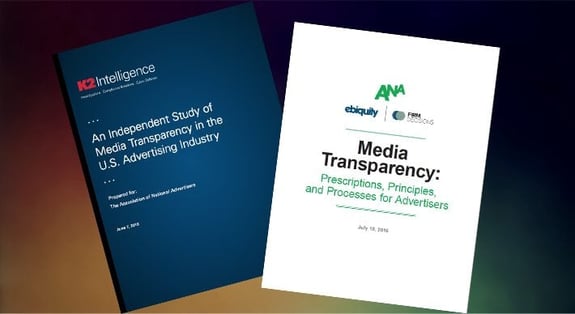The Association of National Advertisers (ANA - the US marketing trade body) recently published the final component of their year-long project to identify the scale of rebate and other non-transparent practices amongst US based media agencies. They offer guidance to those advertisers who may have been exposed to this practice or were entirely unaware of the risks.
We look at the main points of ANA’s advice to marketers, including a strong suggestion that most marketers don’t currently have sufficient capabilities to oversee media management internally. They recommend appointing a Chief Media Officer, someone internally who can champion the role of media within the company, have more accountability for media as an investment for growth and someone who can define the relationship with the agency beyond just buying cheap media.
One pleasant surprise as part of the ANA’s release was the inclusion of a media agency services contract. A template to guide marketers in creating the best media agency contract. This is a great asset, built on the good work that ISBA (the UK's marketer trade body) executed earlier in 2016. ISBA created a best practice media agency contract, ID Comms was heavily involved in the drafting of the contract and supporting guidelines so we can attest to its quality and robustness. The ANA have used ISBA’s template as a basis for their own version for US members. In our review, we believe that the ANA contract template is of best practice standard, but will be hard for advertisers to implement unless they have sufficient negotiation leverage over agencies to get them to accept these terms. That’s the next challenge for marketers, how to put all this stuff into practice.
ID Comms’ perspective on the ANA Media Transparency guidelines:
We welcome the publication of the long-awaited ANA Media Transparency guidelines. If advertisers adopt these guidelines then they will certainly be in a better position than they were 12 months ago. In that sense, the ANA have achieved their goal and done what they said they were going to do, the guidelines are sensible, reasonable, considered and fair. We highly commend the ANA for the rigorous process they have undertaken.
We hope that, at the conclusion of the ANA media transparency investigations, this will draw a line under this difficult and toxic chapter for the industry and that advertisers and their agencies can build more productive relationships together for the future. The guidelines should be considered an opportunity for advertisers and their agencies to reset their relationships, especially where these have been clouded by concerns over trust and transparency. Media is a powerful lever for growth for brands and they need reliable, trusted working relationships with their media agency partners. It is now down to each individual advertiser to define their own course of action to modernise their agency relationships and improve their own media governance capabilities and skills.
The ANA's good work in this area will help us all start to redefine media as a race to the top for brands, not a race to the bottom for low cost and low quality.
This is in a follow up to our perspectives on the first ANA / K2 Media Rebate Report and the ID Comms Manifesto for Media Change which summarises advice given to ID Comms clients to date.
Here we have shared the Executive Summary and linked through to downloads of the full ANA guidelines report and media agency contract template.
ANA MEDIA TRANSPARENCY GUIDELINES
Executive Summary:
The K2 Intelligence study, conducted on behalf of the ANA from October 2015 to May 2016, reported that numerous non-transparent business practices were found to be pervasive in a sample of the U.S. media ad-buying ecosystem. The study identified several critical findings:
- K2 Intelligence found a fundamental disconnect in the advertising industry about the basic nature of the advertiser/agency relationship. In general, advertisers expressed a belief that their agencies were duty-bound to act in their best interests. They also believed that this obligation, essentially a fiduciary duty, extends beyond the stated terms in their agency contracts. While some agency executives expressed similar beliefs, others told K2 Intelligence that their relationship to advertisers was solely defined by the contract between the two parties. Some sources further noted that their obligations to their respective agency holding companies were sometimes in conflict with the interests of their clients.
- Pervasive receipt of non-disclosed rebates, not returned to advertisers, in the forms of cash, free media inventory, and service agreements, was found.
- Potentially problematic agency conduct was concealed by principal transactions, resulting in media agencies sometimes acting on their own account and not always in the best interests of advertisers.
- Inconsistent and questionable media management practices by advertisers were found. This included poor contract stewardship, lagging business practices, and fundamental organizational management issues.
To address these concerns, ANA and Ebiquity/FirmDecisions came together to craft a framework that can be used by advertisers to provide business practice clarity. This framework outlines recommended responsibilities for advertisers and agencies with the objectives of moving purposefully to address the transparency issues identified in the K2 Intelligence study, creating a code of conduct to guide the relationship between advertiser and media agency, and restoring trust — the core of an effective and beneficial relationship.
This framework consists of three key pillars:
- Advertisers should establish overarching media agency management principles that can be easily understood and executed.
- Advertisers should establish primacy over the client/agency relationship. Advertisers should regularly re-evaluate and upgrade internal processes and practices.
- Advertisers and agencies should have a uniform Code of Conduct to guide the relationship and engender trust.
Pillar 1: Advertisers should establish overarching agency management principles that can be easily understood and executed.
Unless otherwise agreed to in writing by the advertiser, agencies should at all times:
- Endeavor to achieve the best available media value to deliver the advertiser’s commercial objectives.
- Act as an agent for a disclosed principal when dealing with third parties on the advertiser’s behalf.
- Execute agency duties in the best interests of the advertiser to achieve optimal return on the advertiser’s media planning strategy and investments.
- Ensure complete transparency in all transactions with parent companies, subsidiaries, affiliates, related parties, and third parties. Err on the side of communicating everything to advertisers.
- Disclose any conflicts of interest prior to entering into any agreement on the advertiser’s behalf. This includes all partnerships, equity investments, and director or advisor roles that could present a potential conflict of interest.
- Permit complete, thorough, and deep audits of the media agency and its parent companies, subsidiaries, affiliates, and related parties with audit partners of the advertiser’s choice to ensure transparency and compliance with the agency’s contractual obligations.
Pillar 2: Advertisers should establish primacy over the client/agency relationship. Advertisers should regularly re-evaluate and upgrade internal processes and practices.
- Advertisers should view the stewardship of their media investments as a shared responsibility among themselves, their media agencies, and affiliated/related parties.
- Advertisers should ensure a thorough understanding of the existing client/agency relationship. This should be re-evaluated on a regular basis to optimize the business relationship with the agency. It is imperative that the advertiser is absolutely clear on when the agency is acting as a principal or as an agent.
- Advertisers should have an optimal media agency contract. Such a contract should provide clarity and understanding while optimizing planning, reporting, analysis, and agency performance. As the media landscape evolves, it is critical that contract provisions be re-evaluated and upgraded as needed. The ANA, in conjunction with its General Counsel, Reed Smith LLP, has developed a media agency Master Media Planning & Buying Services Agreement which can be used by advertisers in developing their own agency agreement.1 Advertisers are under no obligation to use this template. The template can be found at ana.net/contracttemplate.
- The advertiser’s right to audit should extend to all entities covered by the master services agreement, including the AOR, its holding company, and any other affiliated and related companies that are involved in the transactional chain on behalf of the advertiser, including ATDs, barter companies, and other trading affiliates. This should extend to third-party companies where such companies provide services for the advertiser and/or negotiate any deals with suppliers that include the advertiser’s investment.
- Advertisers should improve internal governance. Advertisers need to evaluate the appropriate inclusion of their own CFO, CEO, and Audit Committee of the Board to sign off on the media agency contract and on media agency performance on an annual basis.
- Advertisers should appoint a chief media officer (either in title or function) who should take responsibility for the internal media management and governance processes that deliver performance, media accountability, and transparency throughout the client/agency relationship.
- Demand agency accountability. The agency/holding company CFO should be accountable for all agency performance and compliance with the contract, including adherence to all transparency conditions. This should include a detailed set of reports and analytics that are sent to the client annually and signed by the agency/holding company CFO.
- Upgrade advertiser media management skill sets with an emphasis on digital media as part of a continuous program of media education.
- Regularly evaluate agency compensation to ensure it is equitable and fair, as advertiser pricing pressure may be a factor that is contributing to the proliferation of non-transparent business practices by agencies, according to the K2 Intelligence report.
- Advertisers should take ownership of data, and exert control over media planning and how technology is used on their behalf.
Pillar 3: Advertisers and agencies should have a uniform Code of Conduct to guide the relationship and engender trust.
A strong contractual agreement is the foundation to building a culture of trust between the advertiser and the media agency. To further that objective, the contract should be supported by a Code of Conduct between the advertiser and the media agency. They should work together to ensure that the Code of Conduct is upheld across all entities, relationships, and activities. The Code of Conduct should be signed by both parties and should be an addendum to the master services agreement.







COMMENTS